
Holy Family with the Infant Saint John the Baptist is an unfinished c. 1521 oil on panel painting by Rosso Fiorentino, produced early in his stay in Volterra. The work is now in the Walters Art Museum in Baltimore. [1]

Holy Family with the Infant Saint John the Baptist is an unfinished c. 1521 oil on panel painting by Rosso Fiorentino, produced early in his stay in Volterra. The work is now in the Walters Art Museum in Baltimore. [1]
The devotional altarpiece, unfinished, is usually referred to the early 1520s, at the beginning of the stay in Volterra, due to the close connection with the Villamagna Altarpiece. It shows the Madonna holding the Child standing on a green cushion, placed near the lower edge of the table, while on the left St. Joseph and St. John the Baptist turn towards the Savior, with a very accentuated rotation. The impulse of the Child embracing his mother recalls the Madonna of the Harpies by Andrea del Sarto (1517). The presence of Donatellesque stylistic features have been related to a possible frequentation of Jacopo Sannazzaro in a hypothetical Neapolitan trip of those years.
Typical of the artist are the watery eyes, the restless contour line, the lively and dynamic brushstroke, the tapering of some anatomical details, such as the elegant hand of the Virgin.

Andrea dal Monte Sansovino or Andrea Contucci del Monte San Savino was an Italian sculptor active during the High Renaissance. His pupils include Jacopo Sansovino.
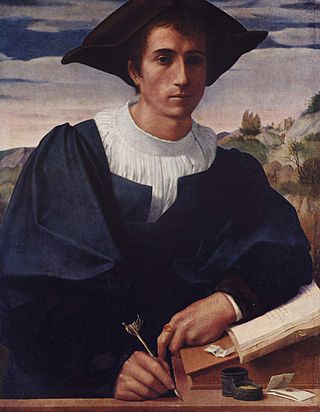
Franciabigio was an Italian painter of the Florentine Renaissance. His true name may have been Francesco di Cristofano; he is also referred to as either Marcantonio Franciabigio or Francia Bigio.

The Descent from the Cross, or Deposition of Christ, is the scene, as depicted in art, from the Gospels' accounts of Joseph of Arimathea and Nicodemus taking Christ down from the cross after his crucifixion. In Byzantine art the topic became popular in the 9th century, and in the West from the 10th century. The Descent from the Cross is the 13th Station of the Cross, and is also the sixth of the Seven Sorrows of the Blessed Virgin Mary.
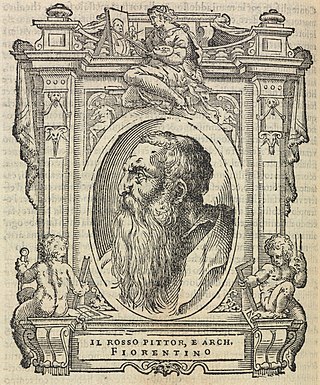
Giovanni Battista di Jacopo, known as Rosso Fiorentino, or Il Rosso, was an Italian Mannerist painter who worked in oil and fresco and belonged to the Florentine school.
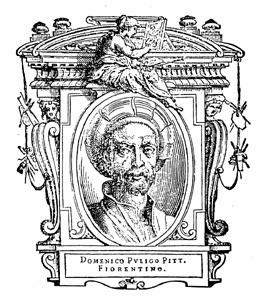
Domenico Puligo (1492–1527) was an Italian painter of the Renaissance, active in Florence. His real name was Domenico di Bartolomeo Ubaldini.
Bartolomeodi Zanobi Ghetti was a Florentine Renaissance painter who has only recently emerged from obscurity as a result of art historical research.
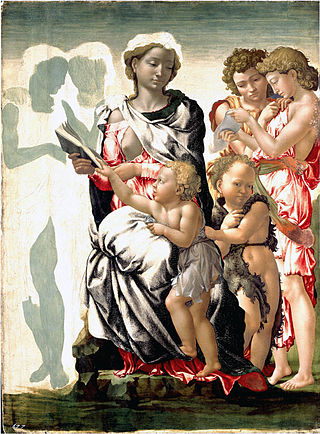
The Madonna and Child with St John and Angels (c. 1497), also known as The Manchester Madonna, is an unfinished painting attributed to Michelangelo in the National Gallery, London. It is one of three surviving panel paintings attributed to the artist and is dated to his first period in Rome. Attribution of the painting to Michelangelo was in doubt for much of the nineteenth and twentieth centuries, but now most scholars are in agreement. The work first came to public attention in the Art Treasures Exhibition in Manchester in 1857, hence the title the “Manchester Madonna”.

Andrea del Sarto was an Italian painter from Florence, whose career flourished during the High Renaissance and early Mannerism. He was known as an outstanding fresco decorator, painter of altar-pieces, portraitist, draughtsman, and colorist. Although highly regarded during his lifetime as an artist senza errori, his renown was eclipsed after his death by that of his contemporaries Leonardo da Vinci, Michelangelo, and Raphael.

The Virgin Enthroned with Saints is a painting by the Italian Renaissance artist Luca Signorelli, dated to 1491 and housed in the Pinacoteca Comunale of Volterra, central Italy.

San Lorenzo is a Renaissance-style, Roman Catholic church located on Via Santa Croce 2 corner with Via Luca Pacioli, in Sansepolcro, province of Arezzo, region of Tuscany, Italy. The church is known for its Rosso Fiorentino masterpiece depicting the Deposition.

The Deposition from the Cross is an altarpiece, completed in 1521, depicting the Deposition of Christ by the Italian Renaissance painter Rosso Fiorentino. The painting is dated and signed: RUBEUS FLOR. A.S. MDXXI. It is broadly considered to be the artist's masterpiece. Painted in oil on wood, the painting was previously located in the Duomo of Volterra, but has been moved to the town art gallery, Pinacoteca Comunale.
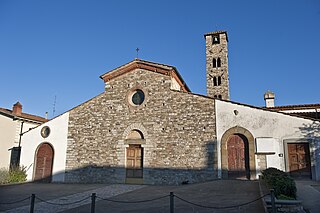
San Donnino is a Romanesque-style, Roman Catholic pieve church located in the frazione of Villamagna, in the territory of the commune of Bagno a Ripoli in the metropolitan city of Florence, region of Tuscany, Italy. The church was founded in the 8th century and rebuilt prior to the 14th century.

The Spedalingo Altarpiece' or Ognissanti Altarpiece is a 1518 oil on panel painting by Rosso Fiorentino, now in the Uffizi in Florence, which acquired it in 1900. It was commissioned by Leonardo Buonafede, "spedalingo" of the Hospital of Santa Maria Nuova in Florence. The contract was dated 30 January 1518. The painting was intended for the St John the Baptist chapel in Ognissanti according to the will of Francesca de Ripoi, a Catalan widow.

Elijah in the Desert is a 1543-1547 oil on panel painting by Daniele da Volterra. With Massacre of the Innocents and Madonna and Child with the Infant St John the Baptist and Saint Barbara, it is one of a number of paintings by the artist now in the Uffizi Gallery in Florence.
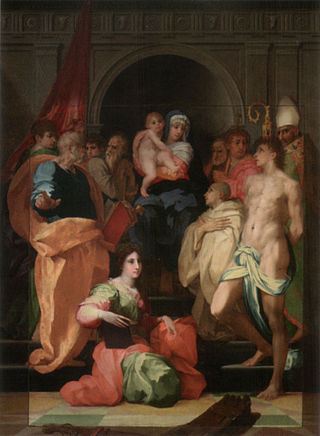
The Dei Altarpiece is an oil on panel painting by Rosso Fiorentino, commissioned in 1509 by the Dei family and completed in 1522. It is now in Florence's Galleria Palatina, whilst the Uffizi holds a preparatory drawing which may be the original idea for the work.
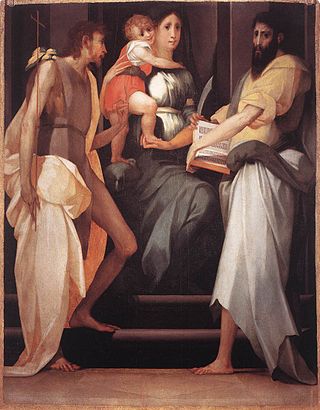
Villamagna Altarpiece is a 1521 oil on panel painting by Rosso Fiorentino, produced for Pieve dei Santi Giovanni Battista e Felicita, Villamagna's parish church, where it remained until the mid 1860s. It is now in the Diocesan Museum in Volterra. The artist's second commission in Volterra after Deposition, it is signed and dated in the lower left-hand corner. To the left of the Madonna and Child is John the Baptist in his camel-skin tunic and holding a cross, whilst to the left is Saint Bartholomew holding an open book and the knife used to flay him.

The Infant Saint John the Baptist is a c.1521 oil on panel painting by Rosso Fiorentino, now in a private collection in Florence. Stylistically close to the artist's Volterra Deposition, its nervy contour lines and gaunt brushstrokes are also similar to his Holy Family with the Infant Saint John the Baptist.

Portrait of a Young Man is an oil on wood painting by Rosso Fiorentino, executed c. 1517–1518, now in the Gemäldegalerie, Berlin.

Madonna and Child with the Infant Saint John the Baptist is an oil on panel painting by Pontormo, now in the Uffizi, whose Gabinetto dei Disegni e delle Stampe also houses a preparatory drawing for the work. The two theories on its dating are 1534-1536 and Antonio Natali's theory of 1529–1530.
Madonna and Child with Saints is a common theme in Christian art, and is thus the title of a number of works.